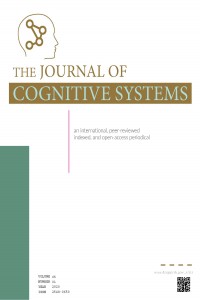Abstract
References
- [1] D. Ciresan, U. Meier, and J. Schmidhuber, “Multi-Column Deep Neural Networks for Image Classification,” Technical Report, arXiv:1202.2745, 2012.
- [2] R. Collobert and J. Weston, “A Unified Architecture for Natural Language Processing: Deep Neural Networks with Multitask Learning,” Proc. Int’l Conf. Machine Learning, 2008.
- [3] Martín Abadi et. al., “TensorFlow: Large-scale machine learning on heterogeneous systems”, 2015. Software available from tensorflow.org.
- [4] Wah C., Branson S., Welinder P., Perona P., Belongie S. “The Caltech-UCSD Birds-200-2011 Dataset.” Computation & Neural Systems Technical Report, CNS-TR-2011-001.
- [5] L. Fei-Fei, R. Fergus and P. Perona. Learning generative visual models from few training examples: an incremental Bayesian approach tested on 101 object categories. IEEE. CVPR 2004, Workshop on Generative-Model Based Vision. 2004.
- [6] AlizaSarlan, ChayanitNadam, ShuibBasri ,”Twitter Sentiment Analysis”.
- [7] KUNAL JAIN,2015,”Scikit-learn in Python – the most important Machine Learning tool I learnt last year!”. Online https://www.analyticsvidhya.com/blog/2015/01/scikit-learn-python-machine-learning-tool/, Accessed:2020-04-29.
- [8] B. Xu, N. Wang, T. Chen, M. Li, Empirical evaluation of rectified activations in convolutional network, arXiv preprint arXiv:1505.00853 , (2015).
- [9] X. Glorot, A. Bordes, and Y. Bengio, “Deep sparse rectifier neural networks,” in Proceedings of the International Conference on Artificial Intelligence and Statistics, pp. 315–323, 2011.
- [10] A. Karpathy, “Commonly used activation functions.” http://cs231n.github.io/linear-classify/#loss. Accessed:2020-04-26.
- [11] D. Kingma, J. Ba, Adam: a method for stochastic optimization, arXiv preprint arXiv:1412.6980 , (2014).
Abstract
Deep learning has become very popular in recent years. Great progress has been made in the task of classifying images with the development of deep learning. This research utilized the deep learning methods in TensorFlow to classify the bird and airplane images. In the first step, a general framework for the classification of deep learning images, an image classification network namely airplane images and bird images are built. Then, the images were randomly chosen from the Caltech-UCSD Birds-200-2011 and Caltech 101 datasets. To correctly classify airplane and bird images, total of 1600 images used. The 1072 images used to train the network and the 528 images used to test built deep learning network. The training phase lasts only 20 epochs to achieve 100% accuracy on the train set. The test data were classified as 99.05% percent. Overall accuracy is 99.69%. This research has a certain importance to explore the use of cognitive systems approach in aviation safety.
Keywords
References
- [1] D. Ciresan, U. Meier, and J. Schmidhuber, “Multi-Column Deep Neural Networks for Image Classification,” Technical Report, arXiv:1202.2745, 2012.
- [2] R. Collobert and J. Weston, “A Unified Architecture for Natural Language Processing: Deep Neural Networks with Multitask Learning,” Proc. Int’l Conf. Machine Learning, 2008.
- [3] Martín Abadi et. al., “TensorFlow: Large-scale machine learning on heterogeneous systems”, 2015. Software available from tensorflow.org.
- [4] Wah C., Branson S., Welinder P., Perona P., Belongie S. “The Caltech-UCSD Birds-200-2011 Dataset.” Computation & Neural Systems Technical Report, CNS-TR-2011-001.
- [5] L. Fei-Fei, R. Fergus and P. Perona. Learning generative visual models from few training examples: an incremental Bayesian approach tested on 101 object categories. IEEE. CVPR 2004, Workshop on Generative-Model Based Vision. 2004.
- [6] AlizaSarlan, ChayanitNadam, ShuibBasri ,”Twitter Sentiment Analysis”.
- [7] KUNAL JAIN,2015,”Scikit-learn in Python – the most important Machine Learning tool I learnt last year!”. Online https://www.analyticsvidhya.com/blog/2015/01/scikit-learn-python-machine-learning-tool/, Accessed:2020-04-29.
- [8] B. Xu, N. Wang, T. Chen, M. Li, Empirical evaluation of rectified activations in convolutional network, arXiv preprint arXiv:1505.00853 , (2015).
- [9] X. Glorot, A. Bordes, and Y. Bengio, “Deep sparse rectifier neural networks,” in Proceedings of the International Conference on Artificial Intelligence and Statistics, pp. 315–323, 2011.
- [10] A. Karpathy, “Commonly used activation functions.” http://cs231n.github.io/linear-classify/#loss. Accessed:2020-04-26.
- [11] D. Kingma, J. Ba, Adam: a method for stochastic optimization, arXiv preprint arXiv:1412.6980 , (2014).
Details
| Primary Language | English |
|---|---|
| Subjects | Electrical Engineering |
| Journal Section | Articles |
| Authors | |
| Publication Date | June 30, 2020 |
| Published in Issue | Year 2020 Volume: 5 Issue: 1 |


